Ozyptila is a genus of crab spiders that was first described by Eugène Louis Simon in 1864. It has been misspelled as "Oxyptila" in multiple accounts.
Euophrys omnisuperstes, the Himalayan jumping spider, is a small jumping spider that lives at elevations of up to 6,700 m (22,000 ft) in the Himalayas, including Mount Everest, making it a candidate for the highest known permanent resident on Earth. They are found among rocky debris, feeding on tiny stray springtails and flies.
Ozyptila atomaria is a species of crab spider with palearctic distribution. It is very common on moist meadows of central Europe.
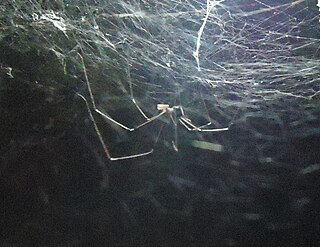
Crossopriza lyoni is a widespread species of cellar spiders that prefer to live in or around human structures. They are commonly known as tailed cellar spiders, tailed daddy longlegs spiders, and sometimes box spiders. They all possess extremely long fragile legs that can reach up to 6 cm (2.4 in) long and a body length of that ranges from 2.5 to 7 mm. Their abdomens are distinctly squarish when viewed from the side and their carapace is more or less circular when viewed from above. They also possess two kinds of sound-producing organs and have six eyes.
Attulus caricis is a species of spider in the family Salticidae. It has a Palearctic distribution, including Britain. Until 2017, it was placed in the genus Sitticus.

Oregonia bifurca, commonly known as the split-nose crab or the split-nose decorator crab, is a species of crabs belonging to the family Oregoniidae. It is a rare deep-water species that inhabits the tops of seamounts and guyots in the northeastern Pacific Ocean; from the Aleutian Islands, the Bering Sea, the Hawaiian–Emperor seamount chain, to the waters off British Columbia. It is closely related to the more common shallow-water species Oregonia gracilis, the graceful decorator crab.

Nothophantes, the horrid ground-weaver, is a critically endangered monotypic genus of European dwarf spiders containing the single species, Nothophantes horridus. It was first described by P. Merrett & R. A. Stevens in 1995, and has only been found in an area of Plymouth smaller than 1 square kilometre (0.39 sq mi). The genus name comes from the Ancient Greek νόθος, meaning "spurious", and hyphantes, meaning "weaver". The species name comes from the Latin horridus, meaning "bristly".
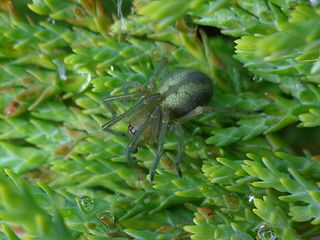
Cheiracanthium erraticum, the two-clawed hunting spider, is a species of Palearctic spider of the family Cheiracanthiidae.

Xysticus cristatus, the common crab spider, is a European spider from the family Thomisidae.
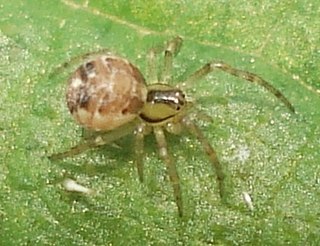
Phylloneta impressa is a species of comb-footed spider from the genus Phylloneta with a Holarctic distribution.
Cryphoeca silvicola is a small species of dwarf sheet spider in the family Cybaeidae which has a Palearctic distribution. The generic name, Cryphoeca, means hidden and the specific name silvicola means "living in the woods".

Salticus cingulatus is a Palearctic jumping spider of the family Salticidae.

Heliophanus cupreus, the copper sun jumper, is a species of jumping spider belonging to the family Salticidae.
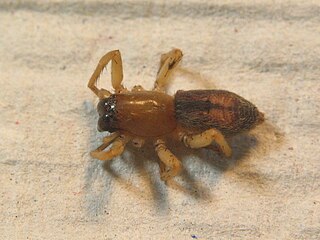
Clubiona subsultans, the Caledonian sac spider, is a spider from the family Clubionidae with a Palearctic distribution.
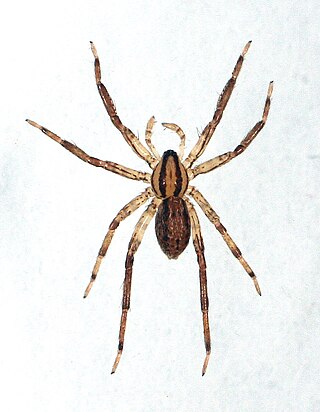
Zora spinimana is a prowling spider of the family Miturgidae with a Palearctic distribution. It is the type species of the genus Zora.

Zelotes subterraneus is a species of ground spider from the family Gnaphosidae which has a Palearctic distribution. it is the type species of the genus Zelotes. Its distribution may be somewhat masked by the difficulty of distinguishing this species from Zelotes apricorum and Zelotes latreillei.

Anitistea elegans, the marsh combtail, is a species of dwarf sheet web spider in the family Hahniidae which has a Palearctic distribution.
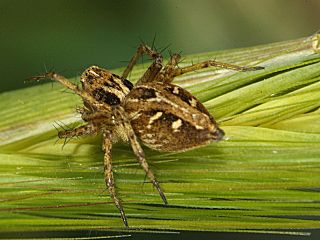
Oxyopes heterophthalmus is a lynx spider from the family Oxyopidae, it is the type species of the genus Oxyopes and was described by Pierre André Latreille in 1804, it has a Palearctic distribution.
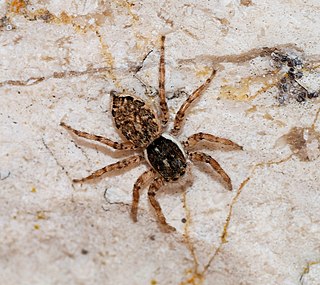
Menemerus animatus is a species of jumping spider in the genus Menemerus that lives across the Mediterranean Basin and into the Afrotropical realm. The species was first described in 1876 by Octavius Pickard-Cambridge based on an example from Egypt. It has subsequently been found living across many countries from Algeria to Greece and Senegal to Yemen. It prefers living in sandy environments.
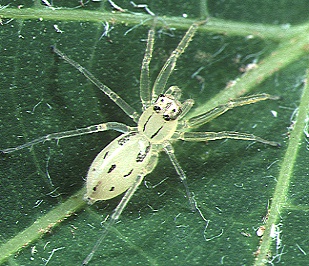
Asemonea murphyae is a species of jumping spider in the genus Asemonea that lives in Kenya and South Africa. First defined in 1980 by Fred Wanless, the spider is named after the British arachnologist Frances M. Murphy. Asemonea murphyae thrives in a wide range of environments, particularly by the side of rivers, streams and tracks. A small spider, with a carapace that is between 1.48 and 2.00 mm long and an abdomen between 2.4 mm long, it is generally yellow with a green tint that enables it to blend into its environment. The female is smaller than the male. The species can be distinguished from other spiders in the same genus by the design of the female's epigyne and the male pedipalp, particularly the male's forked spike on the palpal tibia.















